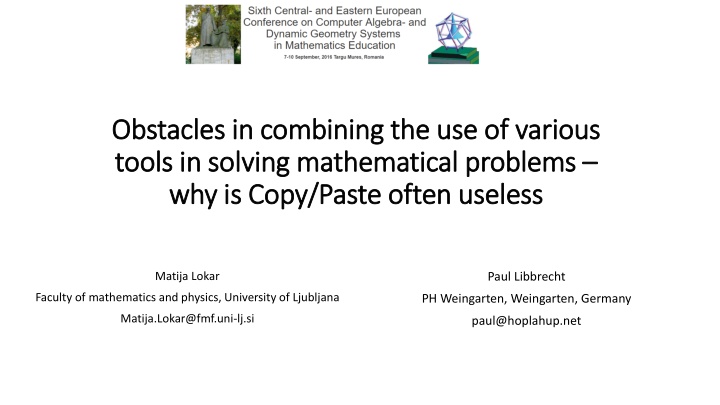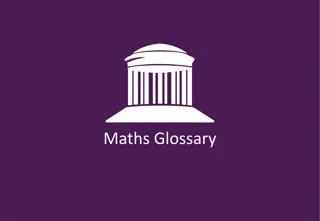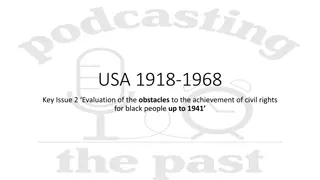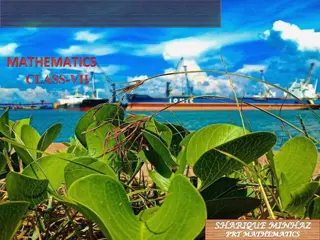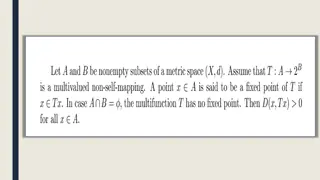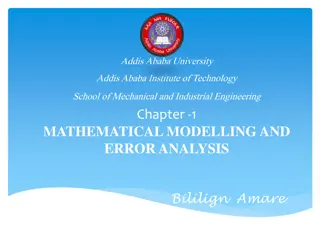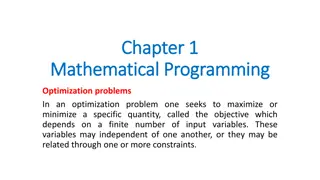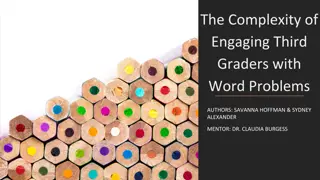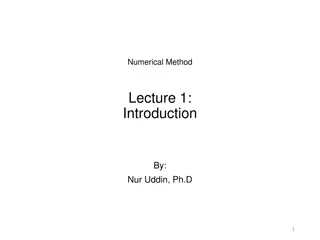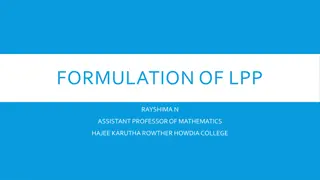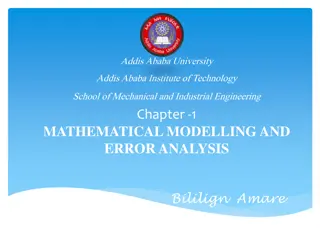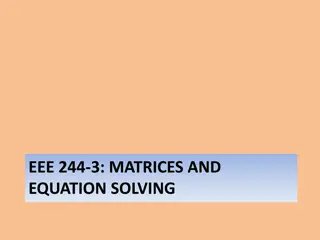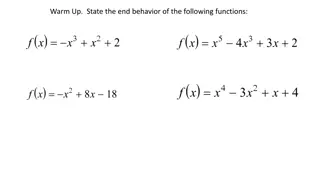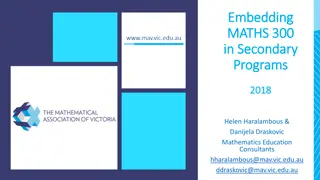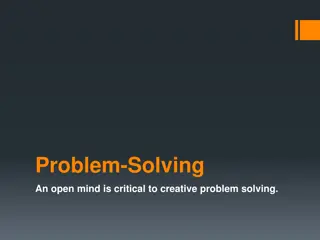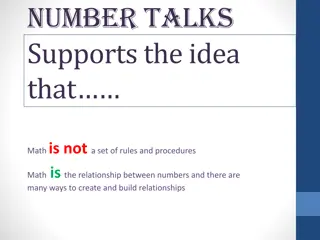Obstacles in Solving Mathematical Problems with Various Tools
Understanding the challenges of combining different tools to solve math problems efficiently. Discusses the limitations of Copy/Paste and experiences from a practical math study program using tools like Mathematica, GeoGebra, and Octave.
Download Presentation

Please find below an Image/Link to download the presentation.
The content on the website is provided AS IS for your information and personal use only. It may not be sold, licensed, or shared on other websites without obtaining consent from the author.If you encounter any issues during the download, it is possible that the publisher has removed the file from their server.
You are allowed to download the files provided on this website for personal or commercial use, subject to the condition that they are used lawfully. All files are the property of their respective owners.
The content on the website is provided AS IS for your information and personal use only. It may not be sold, licensed, or shared on other websites without obtaining consent from the author.
E N D
Presentation Transcript
Obstacles in combining the use of various Obstacles in combining the use of various tools in solving mathematical problems tools in solving mathematical problems why is Copy/Paste often useless why is Copy/Paste often useless Matija Lokar Paul Libbrecht Faculty of mathematics and physics, University of Ljubljana PH Weingarten, Weingarten, Germany Matija.Lokar@fmf.uni-lj.si paul@hoplahup.net
CADGME 2014 Talk Lessons Learned in Course Computer Tools In Mathematics We talked (also) about One tool covering all aspects of teaching and learning mathematics, or many "smaller" tools Interoperability of tools
Course Computer Tools In Mathematics Practical Mathematics First cycle professional study program Emphasis on hands on solving "old mathematical tasks" (from high school) with various tools (Mathematica, GeoGebra, Octave, Excel, Numpy ) Subject specific competences developed by the student: ability of employment of mathematical tools at practical problem solving, ability of result analysis, ability of presentation of results
Experiment Having chosen different widespread software programs, students explored transfers of mathematical object between them using copy and paste.
Background In the first weeks in the course Computer tools in mathematics students get used to some typical examples of mathematical software. They obtained mostly just the basic knowledge, so they know only the most common functions and functionality of the used applications Experiment: To solve (and to report in detail the process of obtaining the solution) a certain mathematical task The usage (within the same task) of different mathematical software has been foreseen Had to report on all difficulties and obstacles
Example Given are points A, B, C and D. Construct a cubic polynomial p(x) through those points. Use GeoGebra to draw it. Select arbitrary point (x, p(x)) and draw a tangent to the graph. To calculate the polynomial, use suitable procedure in OCTAVE. Report about the process, describe steps, justify your findings Report also about the obstacles, difficulties and your impressions when doing this task!
Exchange of mathematical objects Work with several systems of mathematical software Reporting Copy / Paste procedure is expected to be used by students
Copy and paste from the technical point of view An origin place is selected (e.g. with the mouse) It is copied several copies of the content into the system s clipboard, one for each flavor, in order of preference. A target place is selected in a document being edited. The contents of the clipboard is pasted. The application editing that document chooses the best flavor inserts its associated content at the given place.
From Word to Mathematica Word (Equation mode) Insert > Equation marking the expression Ctrl-C (the copy operation) Mathematica Ctrl-V (Paste)
What about text mode Problems with auto format 6-b becomes 6 b (dash!) 1/4 becomes
From Mathematica to Word Problems with peculiarities of Mathematica s syntax like [] for functions' arguments Word Mathematica - Word
GeoGebra and Mathematica GeoGebra CAS mode!
Also with Copy as Copy as MathML
... Copy/Paste method does not work with drawing plots in different programs. For drawing plots each one of used programs has its own language , which we have to use.
When we copied expressions from Word to GeoGebra, it worked in some cases even without changing expressions. If exponents would be written with symbol ^ in Word, there would not be any problems. From there on, some changes and adaptations were necessary, especially when copying expressions from GeoGebra to Mathematica
... I was very rarely able to use Copy/Paste method to transfer expressions between programs and even then some corrections were usually needed for programs to work
After several tries I gave up. The only way to transfer an expression between programs is to manually retype it
To input matrix in X is surprisingly identical to input matrix in Y. But unfortunately here the joy ends.
It has been an extremely tough task. I spent numerous hours doing it. I tried several techniques to force the program to properly copy/paste the expression with no success. Finally, I manually transferred the expressions. But here I had problems again as even the usage of parenthesis not even mentioning the names of the commands was not the same. I do not understand why software producers each one uses their own syntax.
Please do not give us such tasks anymore. It is impossible. All the time switching between different syntax. At the end I did not even know, if I got everything right, even though the mathematics behind was luckily simple enough.
it is all mathematical software and mathematics is just one, so I expected no problems in using Copy/Paste In the discussion afterwards they all express their deep disappointment with the software. When started the task, they mostly all expected there will be no problems or just some minor problems.
Multiple issues Loss of information at copying Preference for pasting plain text when other formats may be more appropriate Misinterpretation of the mathematical notation Lack of usage of more semantic encodings Partial but unpredictable success
Loss of information at copying Loss of information at copying some programs transfer much of the information into the clipboard allowing other programs to recover most information (in principle), many put information in private encodings difficult for other applications to receive in a consistent manner on the long term.
Preference for pasting plain text when other Preference for pasting plain text when other formats may be more appropriate formats may be more appropriate many programs ignore content types that could bring more information expecting that plain text is probably a better guess than, MathML, RTF, or HTML flavors
Misinterpretation of the mathematical Misinterpretation of the mathematical notation notation input of mathematical formul leaves the user quite free to use mathematical notations in different ways usage of the cross-sign for multiplications (fails in C/P Word to Mathematica). different software use different function names which are not properly exchanged
Lack of usage of more semantic encodings Lack of usage of more semantic encodings Most mathematical sofftware systems include a rich set of mathematical operators and functions. interoperability they offer linear syntax (known to be very program-specific) presentation-oriented syntax (such as MathML presentation or pictures).
Partial but unpredictable success Partial but unpredictable success very diverse set of interoperability issues. no way to explain rules to tell when a formula will be transferred successfully.
